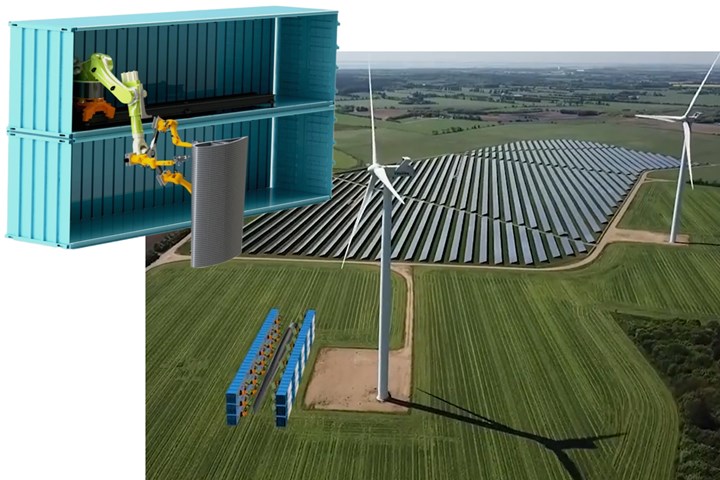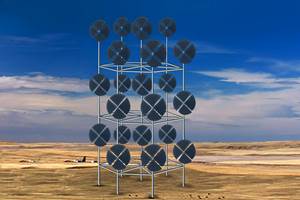Orbital Composites to demonstrate containerized 3D printing robots for AM wind blade manufacture
Project aims to demonstrate additive manufacturing of >100-meter-long composite wind blades with >25% reduced cost.
Orbital Composites (San Jose, Calif., U.S.) will collaborate with Oak Ridge National Laboratory (Oak Ridge, Knoxville, Tenn., U.S.) and the University of Maine (UMaine, Orono, Maine, U.S.) to advance on-site, high-throughput manufacturing of wind blades with large-scale continuous fiber additive manufacturing via a $4 million grant from the U.S. Dept. of Energy (DOE), Office of Energy Efficiency and Renewable Energy (EERE). Orbital notes that this project will also enable the demonstration/potential validation use of its containerized 3D printing robots for wind blade manufacture.
In addition to ORNL’s previous collaboration with Sandia National Laboratory, for a 3D-printed wind turbine blade mold, and UMaine’s 120-foot-long 3D printer, Orbital Composites says it has been quietly pioneering its own accomplishments under its Mobile Robotic Additive Manufacturing with Continuous Fiber, a modular platform which uses a twelve-axis robot arm to enable AM of non-planar surfaces. Having already demonstrated thermoplastic and thermoset AM reinforced with continuous carbon and glass fibers, the company has a vision of eventually building large scale-up systems capable of printing entire wind blades greater than 100 meters in length. Currently, the system’s ORB OS software allows multi-robot collaboration as well.
This goal comes about due to several challenges the wind industry still faces. For example, according to Orbital, with low-cost energy expected to reach 35% of global energy demand by 2050 (driven by wind blade cost reductions), optimal locations for onshore wind farms are forcing operators to build wind farms in harder-to-reach areas. In addition to this, blade transportation is often limited in the U.S. to blade lengths between 53-62 meters by road and rail infrastructure, constraining future cost-reduction potential. A landmark study by the International Energy Agency (IEA, Paris, France) suggests on-site manufacturing as one of the disruptive technologies needed to continue to reduce the cost of wind energy.
Use of Orbital Composites’ containerized robotics, therefore, can potentially make on-site manufacturing a reality. “Shipping containers are the most versatile and lowest-cost method for global relocation,” says Amolak Badesha, co-founder and CEO of Orbital Composites. “Mold transportation costs can be greatly reduced if 3D printing feedstock loaded shipping containers are being transported instead of mold surfaces. Modular, mobile robotics facilitate global logistics.”
A mobile factory may also be the solution for crane use, particularly as offshore wind turbines are built bigger. “The sheer scale of off-shore deployment vessels is an impressive feat, one unmatched by terrestrial cranes. Cranes big enough for land-based, 100-meter-long blades do not exist,” Amolak says. “If the shipping containerized factory can be placed directly beneath the tower, then blade hoist and repair systems may be incorporated into the shipping container superstructure.”
The project
The DOE proposal calls for demonstrating the use of AM for cost-effective scaling of large blade sizes (greater than 100-meter-length), novel AM-enabled blade designs and lower tooling costs. Orbital Composites’ proposal answered the call by offering a comprehensive solution showing a path to manufacturing and transportation cost reduction by more than 25%, increased throughput speeds and reduced labor compared to conventional blade manufacturing processes. Orbital Composites says it can also show how AM can enable a more than 50% reduction in new blade design lead times, allowing wind blade OEMs to introduce a large variety of site-optimized blades with higher efficiency and lower cost of energy (COE).
UMaine will also be incorporating its Offshore Wind Lab to test the wind blade’s strength and fatigue aging of the AM blades, as well as how well they survive lightning strikes.
Orbital Composites also intends to create new, repairable wind turbine blades. “We will push the envelope with mobile manufacturing and embedded sensors,” says Cole Nielsen, founder and CTO of Orbital Composites. “Digital twin operating systems and mobilized industry 4.0 robots can enable wind turbine systems to be monitored, evaluated, tuned and repaired. Mobile robots are truly disruptive tech.”
Potential for future applications
The technical objective of this combined mission is to make on-site manufacturing of wind blades a possibility. According to Orbital Composites, disrupting the current wind turbine blade industry is quite possible; once the technology has successfully been created, the company says, demand for longer wind blades has the potential to soar.
Further, 100-meter continuous fiber structures may revolutionize another industry in the near future: rockets. This claim may be compared to the Saturn V rocket with 110.6-meter-tall and 10.1-meter-wide launch vehicles, or SpaceX’s current Starship plan, which call for a 122-meter-tall and ~10-meter-wide rocket. Both rockets are currently metallic.
Related Content
Drag-based wind turbine design for higher energy capture
Claiming significantly higher power generation capacity than traditional blades, Xenecore aims to scale up its current monocoque, fan-shaped wind blades, made via compression molded carbon fiber/epoxy with I-beam ribs and microsphere structural foam.
Read MoreUpdate: THOR project for industrialized, recyclable thermoplastic composite tanks for hydrogen storage
A look into the tape/liner materials, LATW/recycling processes, design software and new equipment toward commercialization of Type 4.5 tanks.
Read MoreCollins Aerospace to lead COCOLIH2T project
Project for thermoplastic composite liquid hydrogen tanks aims for two demonstrators and TRL 4 by 2025.
Read MoreHonda begins production of 2025 CR-V e:FCEV with Type 4 hydrogen tanks in U.S.
Model includes new technologies produced at Performance Manufacturing Center (PMC) in Marysville, Ohio, which is part of Honda hydrogen business strategy that includes Class 8 trucks.
Read MoreRead Next
“Structured air” TPS safeguards composite structures
Powered by an 85% air/15% pure polyimide aerogel, Blueshift’s novel material system protects structures during transient thermal events from -200°C to beyond 2400°C for rockets, battery boxes and more.
Read MoreVIDEO: High-volume processing for fiberglass components
Cannon Ergos, a company specializing in high-ton presses and equipment for composites fabrication and plastics processing, displayed automotive and industrial components at CAMX 2024.
Read MorePlant tour: Daher Shap’in TechCenter and composites production plant, Saint-Aignan-de-Grandlieu, France
Co-located R&D and production advance OOA thermosets, thermoplastics, welding, recycling and digital technologies for faster processing and certification of lighter, more sustainable composites.
Read More











.jpg;maxWidth=300;quality=90)














